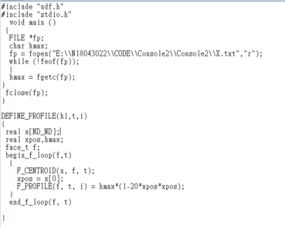c语言,怎样读取一个BMP图片
发布时间:2025-05-12 04:26:05 发布人:远客网络

一、c语言,怎样读取一个BMP图片
void image_channel();//抽取RGB通道
void image_bright();//改变图像亮度
unsigned short bfType;//文件标识 2字节必须为BM
unsigned int bfSize;//文件大小 4字节
unsigned short bfReserved1;//保留,每字节以"00"填写 2字节
unsigned short bfReserved2;//同上 2字节
unsigned int bfOffBits;//记录图像数据区的起始位置(图象数据相对于文件头字节的偏移量)。 4字节
unsigned int biSize;//表示本结构的大小 4字节
int biWidth;//位图的宽度 4字节
int biHeight;//位图的高度 4字节
unsigned short biPlanes;//永远为1, 2字节
unsigned short biBitCount;//位图的位数分为1 4 8 16 24 32 2字节
unsigned int biCompression;//压缩说明 4字节
unsigned int biSizeImage;//表示位图数据区域的大小以字节为单位 4字节
int biXPelsPerMeter;//用象素/米表示的水平分辨率 4字节
int biYPelsPerMeter;//用象素/米表示的垂直分辨率 4字节
unsigned int biClrUsed;//位图使用的颜色索引数 4字节
unsigned int biClrImportant;//对图象显示有重要影响的颜色索引的数目 4字节
extern unsigned char*imagedata;
int times=3;//输入文件名次数。
printf("\nplease enter a file name for reading:");
printf("\nplease enter a file name for reading again:");
//printf("\n%s",bmp_name);
file=fopen(bmp_name,"rb+");//打开一个文件进行读写操作。
printf("\nerror opening%s for reading!",bmp_name);
printf("\nsorry, shutdown!");
fseek(file,0L,0);//读取图像文件类型
fread(&bmp,sizeof(BMP),1,file);
printf("\n bmp tpye:%u",bmp.bfType);
printf("\n bmp size:%u",bmp.bfSize);
printf("\n bmp reserved1:%u",bmp.bfReserved1);
printf("\n bmp reserved2:%u",bmp.bfReserved2);
printf("\n bmp offBits:%u",bmp.bfOffBits);
printf("\n bmp bisize:%u",bmp.biSize);
printf("\n bmp biWidth:%d",bmp.biWidth);
printf("\n bmp biHeight:%d",bmp.biHeight);
printf("\n bmp biplans:%u",bmp.biPlanes);
printf("\n bmp biBitCount:%u",bmp.biBitCount);
printf("\n bmp biCompression:%u",bmp.biCompression);
printf("\n bmp biSizeImage:%u",bmp.biSizeImage);
printf("\n bmp biXPelsPerMeter:%d",bmp.biXPelsPerMeter);
printf("\n bmp biYPelsPerMeter:%d",bmp.biYPelsPerMeter);
printf("\n bmp biClrUsed:%u",bmp.biClrUsed);
printf("\n bmp biClrImportant:%u\n",bmp.biClrImportant);
line_byte=(bmp.biWidth*bmp.biBitCount/8+3)/4*4;//获得图像数据每行的数据个数
//printf("dfsa%u",bmp.line_byte);
imagedata=(unsigned char*)malloc(bmp.biSizeImage);
fseek(file,(long)bmp.bfOffBits,0);
fread(imagedata,sizeof(unsigned char),bmp.biSizeImage,file);
int times=3;//输入文件名次数。
printf("\nplease enter a file name for writeing:");
printf("\nplease enter a file name for writeing again:");
file=fopen(bmp_name,"wb+");//打开一个文件进行读写操作。
printf("\nerror opening%s for writing",bmp_name);
printf("\nsorry, shutdown!");
fseek(file,0L,0);//图像文件类型
fwrite(&(bmp.bfType),sizeof(short),1,file);
printf("\n bmp tpye:%d",bmp.bfType);
fseek(file,2L,0);//图像文件大小
fwrite(&(bmp.bfSize),sizeof(int),1,file);
printf("\n bmp size:%d",bmp.bfSize);
fseek(file,6L,0);//图像文件保留字1
fwrite(&(bmp.bfReserved1),sizeof(short),1,file);
printf("\n bmp reserved1:%d",bmp.bfReserved1);
fseek(file,8L,0);//图像文件保留字2
fwrite(&(bmp.bfReserved2),sizeof(short),1,file);
printf("\n bmp reserved2:%d",bmp.bfReserved2);
fseek(file,10L,0);//数据区的偏移量
fwrite(&(bmp.bfOffBits),sizeof(short),1,file);
printf("\n bmp offBits:%d",bmp.bfOffBits);
fseek(file,14L,0);//文件头结构大小
fwrite(&(bmp.biSize),sizeof(int),1,file);
printf("\n bmp bisize:%d",bmp.biSize);
fseek(file,18L,0);//图像的宽度
fwrite(&(bmp.biWidth),sizeof(int),1,file);
printf("\n bmp biWidth:%d",bmp.biWidth);
fseek(file,22L,0);//图像的高度
fwrite(&(bmp.biHeight),sizeof(int),1,file);
printf("\n bmp biHeight:%d",bmp.biHeight);
fseek(file,24L,0);//图像的面数
fwrite(&(bmp.biPlanes),sizeof(short),1,file);
printf("\n bmp biplans:%d",bmp.biPlanes);
fseek(file,28L,0);//图像一个像素的字节数
fwrite(&(bmp.biBitCount),sizeof(short),1,file);
printf("\n bmp biBitCount:%d",bmp.biBitCount);
fseek(file,30L,0);//图像压缩信息
fwrite(&(bmp.biCompression),sizeof(short),1,file);
printf("\n bmp biCompression:%d",bmp.biCompression);
fseek(file,34L,0);//图像数据区的大小
fwrite(&(bmp.biSizeImage),sizeof(int),1,file);
printf("\n bmp biSizeImage:%d",bmp.biSizeImage);
fseek(file,38L,0);//水平分辨率
fwrite(&(bmp.biXPelsPerMeter),sizeof(int),1,file);
printf("\n bmp biXPelsPerMeter:%d",bmp.biXPelsPerMeter);
fseek(file,42L,0);//垂直分辨率
fwrite(&(bmp.biYPelsPerMeter),sizeof(int),1,file);
printf("\n bmp biYPelsPerMeter:%d",bmp.biYPelsPerMeter);
fseek(file,46L,0);//颜色索引数
fwrite(&(bmp.biClrUsed),sizeof(int),1,file);
printf("\n bmp biClrUsed:%d",bmp.biClrUsed);
fseek(file,50L,0);//重要颜色索引数
fwrite(&(bmp.biClrImportant),sizeof(int),1,file);
printf("\n bmp biClrImportant:%d\n",bmp.biClrImportant);
fseek(file,(long)(bmp.bfOffBits),0);
fwrite(imagedata,sizeof(unsigned char),bmp.biSizeImage,file);
for(i=0;i<bmp.biHeight;i++)
for(j=0;j<line_byte/3;j++)
tmp=0.11*(*(imagedata+i*line_byte+j*3+0))+0.59*(*(imagedata+i*line_byte+j*3+1))+0.3*(*(imagedata+i*line_byte+j*3+2));
imagedata[i*line_byte+j*3+0]=tmp;
imagedata[i*line_byte+j*3+1]=tmp;
imagedata[i*line_byte+j*3+2]=tmp;
//printf("\nnidsfh%d%d",i,j);
for(i=0;i<bmp.biHeight;i++)
if((*(imagedata+i*line_byte+j))<128)
imagedata[i*line_byte+j]=255;
for(i=0;i<bmp.biHeight;i++)
imagedata[i*line_byte+j]=abs(255-imagedata[i*line_byte+j]);
void image_channel()//抽取RGB通道
printf("\nplease enter a char(r/g/b):");
for(i=0;i<bmp.biHeight;i++)
for(j=0;j<line_byte/3;j++)
imagedata[i*line_byte+3*j+1]=0;
imagedata[i*line_byte+3*j+2]=0;
for(i=0;i<bmp.biHeight;i++)
for(j=0;j<line_byte/3;j++)
imagedata[i*line_byte+3*j]=0;
imagedata[i*line_byte+3*j+2]=0;
for(i=0;i<bmp.biHeight;i++)
for(j=0;j<line_byte/3;j++)
imagedata[i*line_byte+3*j]=0;
imagedata[i*line_byte+3*j+1]=0;
void image_bright()//改变图像亮度
printf("\n please enter the level of brightness[-255 to 255]:");
for(i=0;i<bmp.biHeight;i++)
if((imagedata[i*line_byte+j]+level)>255)
imagedata[i*line_byte+j]=255;
imagedata[i*line_byte+j]+=level;
if((imagedata[i*line_byte+j]-abs(level))<0)
imagedata[i*line_byte+j]+=level;
//void image_create()//创建一幅24位BMP图像文件。
image_info(file);//imagedata已经分配了动态内存,但是没有释放
printf("\n 1.image_opposite");
printf("\n 2.image_gray");
printf("\n 3.image_binarization");
printf("\n 4.image_channel");
printf("\n 5.image_brightness");
printf("\nchoose your options:");
printf("\n wrong choose!");
printf("\nlet's go on?(y/n):");
二、C语言 读取黑白BMP图
黑白BMP文件图的像素大多是从62字节(从0数起)开始。具体从哪一字节开始,
决定于文件中第10字节(从0数起)开始处4字节的整形数是多少.
因为文件头后面不是紧接着像素值.
黑白BMP图的一个像素用一个bit表示。一般0表示背景(缺省为白色),1表示前景色(缺省为黑色)。即一个字节代表相邻的8个像素。
320*240的黑白BMP图,每行320个像素用40个字节表示,240行,应占40*240=9600字节。加上前头62字节,文件大小应为9662字节。
BMP图像素的存储顺序是自底向上。所以文件最后40个字节表示的是第一行的像素值。
行宽如不是8的倍数,也扩展到8的倍数。如行宽321,
则每行像素需用41个字节存储。你的行宽320,恰好是8的倍数,没有这个问题。
三、如何用C语言程序从bmp格式的图片中读取图片的灰度值
1、fp=fopen("Lena.raw","rb");//打开文件。注意raw格式图像要以只读二进制流的形式打开
2、unsignedchar*pData=newunsignedchar[256*256];//注意:raw图像用无符号char型读入
3、fread(pData,sizeof(unsignedchar),(256*256),fp);//fread具体用法见msdn
4、intvalue[256]={0};//声明并初始化存灰度值的数组
5、for(i=0;i<(256*256);i++)//统计灰度值
6、fprintf(fp,"灰度值\t\t大小\r\n");//注意\r\n否则不能换行!
7、for(j=0;j<256;j++)//将结果输出到txt中
8、printf("%d\t\t%d\n",j,value[j]);
9、//fwrite(value,sizeof(int),256,fp);
10、fprintf(fp,"%d\t\t%d\r\n",j,value[j]);//注意\r\n否则不能换行
11、intfread(unsignedchar*pData)//把声明的那个数组空间指针作为参数来回传
12、fread(pData,sizeof(unsignedchar),(256*256),fp);
13、for(inti=0;i<(256*256);i++)//统计灰度值
14、fprintf(fp,"灰度值\t\t大小\r\n");
15、for(intj=0;j<256;j++)//将结果输出到txt中
16、printf("%d\t\t%d\n",j,value[j]);
17、//fwrite(value,sizeof(int),256,fp);
18、fprintf(fp,"%d\t\t%d\r\n",j,value[j]);
19、pData=newunsignedchar[256*256];//在主函数里声明新空间






